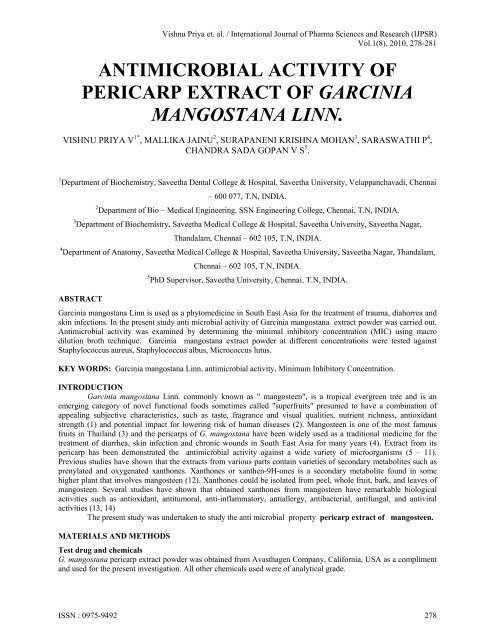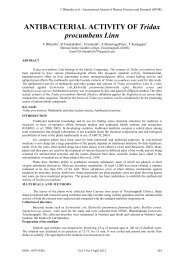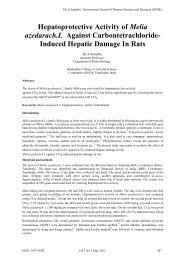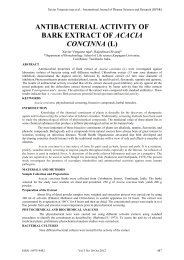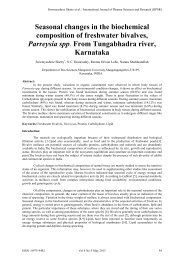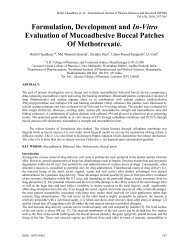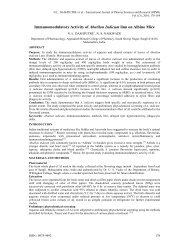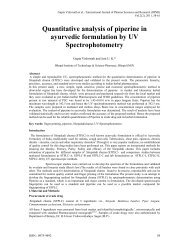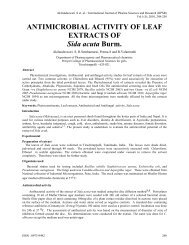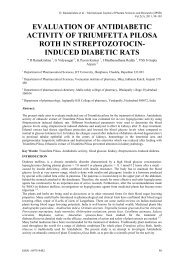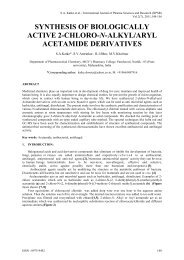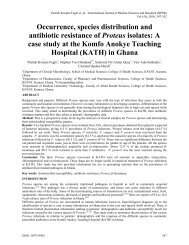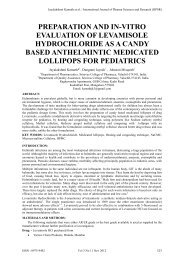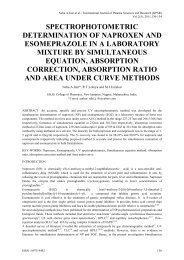antimicrobial activity of pericarp extract of garcinia mangostana linn.
antimicrobial activity of pericarp extract of garcinia mangostana linn.
antimicrobial activity of pericarp extract of garcinia mangostana linn.
Create successful ePaper yourself
Turn your PDF publications into a flip-book with our unique Google optimized e-Paper software.
Vishnu Priya et. al. / International Journal <strong>of</strong> Pharma Sciences and Research (IJPSR)<br />
Vol.1(8), 2010, 278-281<br />
ANTIMICROBIAL ACTIVITY OF<br />
PERICARP EXTRACT OF GARCINIA<br />
MANGOSTANA LINN.<br />
VISHNU PRIYA V 1* , MALLIKA JAINU 2 , SURAPANENI KRISHNA MOHAN 3 , SARASWATHI P 4 ,<br />
CHANDRA SADA GOPAN V S 5 .<br />
1 Department <strong>of</strong> Biochemistry, Saveetha Dental College & Hospital, Saveetha University, Velappanchavadi, Chennai<br />
– 600 077, T.N, INDIA.<br />
2 Department <strong>of</strong> Bio – Medical Engineering, SSN Engineering College, Chennai, T.N, INDIA.<br />
3 Department <strong>of</strong> Biochemistry, Saveetha Medical College & Hospital, Saveetha University, Saveetha Nagar,<br />
Thandalam, Chennai – 602 105, T.N, INDIA.<br />
4 Department <strong>of</strong> Anatomy, Saveetha Medical College & Hospital, Saveetha University, Saveetha Nagar, Thandalam,<br />
Chennai – 602 105, T.N, INDIA.<br />
5 PhD Supervisor, Saveetha University, Chennai, T.N, INDIA.<br />
ABSTRACT<br />
Garcinia <strong>mangostana</strong> Linn is used as a phytomedicine in South East Asia for the treatment <strong>of</strong> trauma, diahorrea and<br />
skin infections. In the present study anti microbial <strong>activity</strong> <strong>of</strong> Garcinia <strong>mangostana</strong> <strong>extract</strong> powder was carried out.<br />
Antimicrobial <strong>activity</strong> was examined by determining the minimal inhibitory concentration (MIC) using macro<br />
dilution broth technique. Garcinia <strong>mangostana</strong> <strong>extract</strong> powder at different concentrations were tested against<br />
Staphylococcus aureus, Staphylococcus albus, Micrococcus lutus.<br />
KEY WORDS: Garcinia <strong>mangostana</strong> Linn, <strong>antimicrobial</strong> <strong>activity</strong>, Minimum Inhibitory Concentration.<br />
INTRODUCTION<br />
Garcinia <strong>mangostana</strong> Linn. commonly known as " mangosteen", is a tropical evergreen tree and is an<br />
emerging category <strong>of</strong> novel functional foods sometimes called "superfruits" presumed to have a combination <strong>of</strong><br />
appealing subjective characteristics, such as taste, fragrance and visual qualities, nutrient richness, antioxidant<br />
strength (1) and potential impact for lowering risk <strong>of</strong> human diseases (2). Mangosteen is one <strong>of</strong> the most famous<br />
fruits in Thailand (3) and the <strong>pericarp</strong>s <strong>of</strong> G. <strong>mangostana</strong> have been widely used as a traditional medicine for the<br />
treatment <strong>of</strong> diarrhea, skin infection and chronic wounds in South East Asia for many years (4). Extract from its<br />
<strong>pericarp</strong> has been demonstrated the <strong>antimicrobial</strong> <strong>activity</strong> against a wide variety <strong>of</strong> microorganisms (5 – 11).<br />
Previous studies have shown that the <strong>extract</strong>s from various parts contain varieties <strong>of</strong> secondary metabolites such as<br />
prenylated and oxygenated xanthones. Xanthones or xanthen-9H-ones is a secondary metabolite found in some<br />
higher plant that involves mangosteen (12). Xanthones could be isolated from peel, whole fruit, bark, and leaves <strong>of</strong><br />
mangosteen. Several studies have shown that obtained xanthones from mangosteen have remarkable biological<br />
activities such as antioxidant, antitumoral, anti-inflammatory, antiallergy, antibacterial, antifungal, and antiviral<br />
activities (13, 14)<br />
The present study was undertaken to study the anti microbial property <strong>pericarp</strong> <strong>extract</strong> <strong>of</strong> mangosteen.<br />
MATERIALS AND METHODS<br />
Test drug and chemicals<br />
G. <strong>mangostana</strong> <strong>pericarp</strong> <strong>extract</strong> powder was obtained from Avasthagen Company, California, USA as a compliment<br />
and used for the present investigation. All other chemicals used were <strong>of</strong> analytical grade.<br />
ISSN : 0975-9492 278
Protocols for anti-bacterial <strong>activity</strong>:<br />
Vishnu Priya et. al. / International Journal <strong>of</strong> Pharma Sciences and Research (IJPSR)<br />
Vol.1(8), 2010, 278-281<br />
6 mg <strong>of</strong> the <strong>extract</strong> was mixed with 300 micro lit <strong>of</strong> DMSO so as to get a concentration <strong>of</strong> 20 micro gm in 1 micro lit<br />
<strong>of</strong> the suspension. 5ul, 10ul, 15ul, 20ul and 25ul volume <strong>of</strong> <strong>extract</strong> was loaded on to sterile discs corresponding to<br />
the concentrations as shown in the Table - I.<br />
Table – I: IT SHOWS THE LOADING OF THE EXTRACT ON TO THE STERILE DISCS.<br />
Volume Concentration <strong>of</strong> <strong>extract</strong><br />
5µl 100µg<br />
10 µl 200µg<br />
15 µl 300µg<br />
20 µl 400µg<br />
25 µl 500µg<br />
The herbal <strong>extract</strong> in different concentration (above mentioned) was tested against Staphylococcus aureus, S. albus<br />
and Micrococci for antibacterial <strong>activity</strong> separately. After 24 hours incubation period the plates were observed and<br />
the inhibition-zone was recorded as given in the Table - II.<br />
TABLE – II: IT SHOWS THE RECORDING OF THE INHIBITION ZONE AFTER THE INCUBATION PERIOD.<br />
Strain<br />
Staphylococcus<br />
aureus<br />
Staphylococcus<br />
albus<br />
Micrococci<br />
Concentration <strong>of</strong> <strong>extract</strong><br />
100 µg 200 µg 300 µg 400 µg 500 µg<br />
8mm 8mm 9mm 10mm 12mm<br />
9mm 10mm 12mm 13mm 17mm<br />
8mm 9mm 10mm 11mm 14mm<br />
MINIMAL INHIBITORY CONCENTRATION (MIC):<br />
A serial 2-fold broth dilution method was performed to determine the MICs <strong>of</strong> herbal <strong>extract</strong>s against bacterial<br />
strains. Stationary-phase cultures <strong>of</strong> all strains were prepared by inoculating fresh broth tubes and incubating at<br />
37°C till 0.5 Mc Farlands standard was achieved. Serial 2-fold dilutions were prepared from <strong>extract</strong> stock solutions<br />
and 1.0 mL <strong>of</strong> each standardized bacterial suspension was added to an equal volume <strong>of</strong> each <strong>extract</strong> dilution. After<br />
incubation for 24 h ± 1 h at 37 ° C, turbidity <strong>of</strong> the cultures was assessed visually by comparison to uninoculated<br />
controls. The MIC was defined as the lowest concentration <strong>of</strong> <strong>extract</strong> where bacterial growth was not detected. The<br />
MICs were determined from independent triplicate assays and were based on a serial 2-fold dilution starting with the<br />
initial concentration <strong>of</strong> 400 µg / ml.<br />
ISSN : 0975-9492 279
Vishnu Priya et. al. / International Journal <strong>of</strong> Pharma Sciences and Research (IJPSR)<br />
Vol.1(8), 2010, 278-281<br />
TABLE – III: IT SHOWS THE MINIMAL INHIBITORY CONCENTRATIONS OF S. AUREUS, S.ALBUS AND MICROCOCCI.<br />
Strain<br />
Concentration <strong>of</strong> <strong>extract</strong><br />
400µg / ml 200 µg / ml 100 µg / ml 50µg / ml 25µg / ml 12.5µg/ml<br />
S. aureus NG NG Turbidity Turbidity Turbidity<br />
S. albus NG NG NG NG<br />
Micrococci NG NG NG NG<br />
The MIC for S. aureus 200 µg / ml and S. albus and Micrococci is 50µg/ml.<br />
RESULTS & DISCUSSION<br />
Turbidity<br />
Turbidity Turbidity<br />
Turbidity Turbidity<br />
Results obtained in our present study revealed the anti bacterial <strong>activity</strong> <strong>of</strong> Pericarp <strong>extract</strong> <strong>of</strong> Garcinia<br />
<strong>mangostana</strong> against Staphylococcus aureus, Staphylococcus albus, Micrococcus lutus (Table - II & Table - III).<br />
Microbial susceptibility assays using the disc diffusion method and the Minimal Inhibitory Concentration (MIC)<br />
were carried out for Staphylococcus aureus, Staphylococcus albus, Micrococcus lutus. When tested by the disc<br />
diffusion method, the Pericarp <strong>extract</strong> <strong>of</strong> Garcinia <strong>mangostana</strong> showed significant <strong>activity</strong> against Staphylococcus<br />
aureus, Micrococcus lutus and Staphylococcus albus at 12 mm, 14mm and 17mm respectively. The anti bacterial<br />
<strong>activity</strong> <strong>of</strong> the <strong>extract</strong> was especially notable. The Minimum Inhibitory Concentration (MIC) for Staphylococcus<br />
aureus is 200 µg / ml and Micrococcus lutus and Staphylococcus albus is 50µg/ml. The <strong>extract</strong> from mangosteen<br />
<strong>pericarp</strong> has been known for its broad-spectrum antibacterial <strong>activity</strong> against several Gram-positive and Gramnegative<br />
bacteria, especially those associated with skin infection, diarrhea, tuberculosis or acne (5 - 10). The active<br />
chemical components that are present in medicinal plants like Garcinia <strong>mangostana</strong> were responsible for its anti<br />
microbial <strong>activity</strong> (15). Among xanthone derivatives from mangosteen <strong>extract</strong>, α-mangostin has been known to exert<br />
the most potent <strong>antimicrobial</strong> <strong>activity</strong> (5 – 9, 11). Kitti Torrungruang et al showed the antibacterial <strong>activity</strong> <strong>of</strong><br />
mangosteen Pericarp <strong>extract</strong> against cariogenic Streptococcus mutans (16).<br />
CONCLUSION<br />
The <strong>extract</strong> from mangosteen <strong>pericarp</strong> was effective against Staphylococcus aureus, Staphylococcus albus,<br />
Micrococcus lutus. The strong anti bacterial <strong>activity</strong> <strong>of</strong> the <strong>extract</strong> suggests that it is a good drug <strong>of</strong> choice for<br />
which might be helpful in preventing the progress <strong>of</strong> various diseases and it can be used in alternative system <strong>of</strong><br />
medicine.<br />
REFERENCES<br />
[1] Primchanien Moongkarndi , Nuttavut Kosema, Sineenart Kaslungka, Omboon Luanratana, Narongchai Pongpan and Neelobol Neungton.<br />
Antiproliferation, anti oxidation and induction <strong>of</strong> apoptosis by Garcinia <strong>mangostana</strong> (mangosteen) on SKBR3 human breast cancer cell line.<br />
Journal Of Ethnopharmacology. 2004 Jan; 90 (1):161-6.<br />
[2] José Pedraza-Chaverri, Noemí Cárdenas-Rodríguez, Marisol Orozco-Ibarra and Jazmin M. Pérez-Rojas. Medicinal properties <strong>of</strong><br />
mangosteen (Garcinia <strong>mangostana</strong>). Journal <strong>of</strong> food and toxicology. 2008; 3: 24-27.<br />
[3] Antioxidant and <strong>antimicrobial</strong> activities <strong>of</strong> crude <strong>extract</strong>s from mangosteen (Garcinia <strong>mangostana</strong> L.) parts and some essential oils.<br />
Palakawong, C., Sophanodora, P., Pisuchpen, S. and Phongpaichit, S. International Food Research Journal. 2010; 17: 583-589.<br />
[4] Mahabusarakam W, Wiriyachitra P and Taylor WC. Chemical constituents <strong>of</strong> Garcinia <strong>mangostana</strong>. Journal <strong>of</strong> Natural Products. 1987; 50:<br />
474 - 478.<br />
[5] Iinuma M, Tosa H, Tanaka T, Asai F, Kobayashi Y, Shimano R, et al. Antibacterial <strong>activity</strong> <strong>of</strong> xanthones from guttiferaeous plants against<br />
methicillin-resistant Staphylococcus aureus. J Pharm Pharmacol. 1996; 48: 861 - 5.<br />
[6] Sundaram BM, Gopalakrishnan C, Subramanian S, Shankaranarayanan D, Kameswaran L. Antimicrobial activities <strong>of</strong> Garcinia<br />
<strong>mangostana</strong>. Planta Med. 1983; 48: 59 - 60.<br />
[7] Mahabusarakum W, Phongpaichit S, Jansakul C, Wiriyachitra P. Screening <strong>of</strong> antibacterial <strong>activity</strong> <strong>of</strong> chemicals from Garcinia<br />
<strong>mangostana</strong>. Songklanakarin J Sci Technol. 1983; 5: 337-40.<br />
[8] Mahabusarakam W, Wiriyachitra P, Phongpaichit S. Antimicrobial activities <strong>of</strong> chemical constituents from Garcinia <strong>mangostana</strong> Linn. J<br />
Sci Soc Thailand. 1986; 12: 239-42.<br />
ISSN : 0975-9492 280
Vishnu Priya et. al. / International Journal <strong>of</strong> Pharma Sciences and Research (IJPSR)<br />
Vol.1(8), 2010, 278-281<br />
[9] Suksamrarn S, Suwannapoch N, Phakhodee W,Thanuhiranlert J, Ratananukul P, Chimnoi N, et al. Antimycobacterial <strong>activity</strong> <strong>of</strong> prenylated<br />
xanthones from the fruits <strong>of</strong> Garcinia <strong>mangostana</strong>. Chem Pharm Bull (Tokyo). 2003; 51: 857-9.<br />
[10] Sakagami Y, Iinuma M, Piyasena KG, Dharmaratne HR. Antibacterial <strong>activity</strong> <strong>of</strong> alpha-mangostin against vancomycin resistant<br />
Enterococci (VRE) and synergism with antibiotics. Phytomedicine. 2005; 12: 203-8.<br />
[11] Chomnawang MT, Surassmo S, Nukoolkarn VS, Gritsanapan W. Antimicrobial effects <strong>of</strong> Thai medicinal plants against acne-inducing<br />
bacteria. J Ethnopharmacol. 2005; 101: 330-3.<br />
[12] Peres, V., Nagem, T. J. and de Oliveira, F. F. Tetraoxygenated naturally occurring xanthones. Phytochemistry. 2000; 55: 683-710.<br />
[13] Suksamrarn, S., Komutiban, O., Ratananukul, P., Chimnoi, N., Lartpornmatulee, N. and Suksamrarn, A. Cytotoxic prenylated xanthones<br />
from the young fruit <strong>of</strong> Garcinia <strong>mangostana</strong>. Chemical & Pharmaceutical Bulletin. 2006; 54: 301-305.<br />
[14] Pedraza-Chaverri, J., Cardenas-Rodriguez, N., Orozco- Ibarra, M. and Perez-Rojas, J. M. Medicinal properties <strong>of</strong> mangosteen (Garcinia<br />
<strong>mangostana</strong>). Food Chemistry and Toxicology. 2008; 46: 3227-3239.<br />
[15] Priscila Ikeda Ushimaru1, Mariama Tomaz Nogueira da Silva, Luiz Claudio Di Stasi, Luciano Barbosa, Ary Fernandes Junior.<br />
Antibacterial <strong>activity</strong> <strong>of</strong> medicinal plant <strong>extract</strong>s Brazilian Journal <strong>of</strong> Microbiology. 2007; 38: 717-719.<br />
[16] Kitti Torrungruang, Piraporn Vichienroj, Suchada Chutimaworapan. Antibacterial <strong>activity</strong> <strong>of</strong> mangosteen <strong>pericarp</strong> <strong>extract</strong> against<br />
cariogenic Streptococcus mutans. CU Dent J. 2007; 30: 1-10.<br />
ISSN : 0975-9492 281


